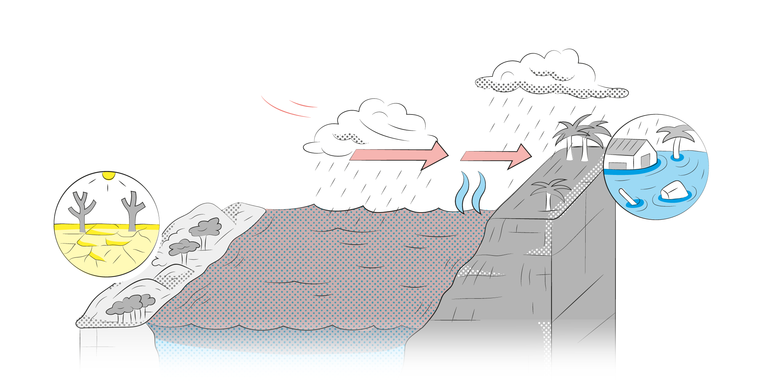


El Niño and La Niña, the 'enfants terribles' of the climate
Investigation'The Earth's pulses' (3/6). Combined with climate change, these two climatic phenomena could have even more unpredictable and devastating consequences for many populations.
El Niño is back and the world is shaking. Yet its name, which in English translates to "The Boy," conjures up images of an endearing Cherub, despite his mischief. At the height of its fury, the climate phenomenon is anything but a wise child. It has extremely harmful effects, triggering violent floods in California, severe droughts and gigantic fires in Australia, cyclones in Polynesia, fishing collapses in Peru and reductions in rice production in Asia. In the past, it has even been accused of accelerating the fall of civilizations. A demon rather than an angel.
El Niño may be feared, but it also fascinates the scientists who study it, because it is such a master of the climate, a natural disturbance that causes the greatest seasonal and annual variations in the climate system. With its equally dangerous twin, La Niña, they tell the story of the ocean and the atmosphere, how the two forces come together in a marriage that has lasted for millions of years, and whose crises regularly upset the Earth's climate.
El Niño and La Niña follow one another in a cycle known as ENSO (El Niño – Southern Oscillation). The first phase of ENSO, the warm phase, is associated with a warming of the equatorial Pacific, which raises global temperatures. The second, the cold phase, causes the opposite. These two sides of the same coin usually last between nine months and a year, and occur irregularly every two to seven years. The last La Niña episode ended in 2022 after having lasted for three consecutive years (2020–2021–2022), a rare occurrence.
Since June, the sister has given way to the brother. El Niño is set to strengthen throughout the fall before reaching its peak intensity between December and January, hence its name, which also means Christ Child in Spanish. "The arrival of El Niño will significantly increase the likelihood of record-breaking temperatures and more extreme heat in many parts of the world and in the oceans," said Petteri Taalas, secretary general of the World Meteorological Organization (WMO), in early July, calling on countries to prepare.
Explosive cocktail
Governments and meteorological agencies around the world are watching for the slightest movement of the enfant terrible of the Pacific. While Indonesia has been stocking up on rice, humanitarian organizations have been stocking up on foodstuffs in the Horn of Africa. El Niño's impact is major and global, thanks to the tropical Pacific representing a quarter of the planet's surface.
The world is entering uncharted territory. On average, the phenomenon causes global temperatures to rise by around 0.2°C. Month after month, the probability increases that 2023 or 2024 will dethrone 2016 as the hottest year on record. The latter was already marked by a strong El Niño. But seven years ago, the concentration of greenhouse gases in the atmosphere owing to human activity was much lower, and therefore global warming was less severe.
You have 84.99% of this article left to read. The rest is for subscribers only.
